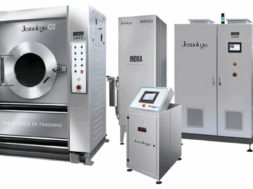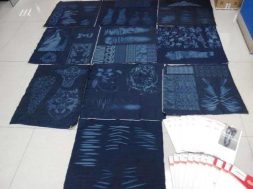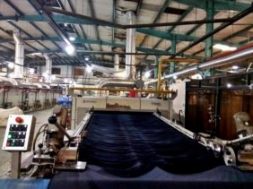Different Types of Chemicals Used in Denim Washing Industries
Different Types of Chemicals Used in Denim Washing Industries :
Denim raw fabrics are sewn into denim raw garments like pants , shirts etc. and to give them a fashionable look, different types of chemicals are used in different stages. Chemicals with certain parameters, quantities and conditions provides those garments a different outlook.
List of chemicals Used in Denim Washing :
- Enzymes
- Detergents
- Caustic Soda ( NaoH )
- Soda Ash ( Na2CO3 )
- Acetic Acid ( CH3COOH )
- Hydrogen Peroxide ( H2O2 )
- Anti Backstainer
- Whitening agent
- Anti Creasing agent
- Bleaching powder – Ca(OCl)Cl , NaOCl
- Potasium permanganate – KMnO4
- Sodium Meta By Sulphate – ( Na2S2O5 )
- Sodium thiosulfate – Hypo (Na2S2O3 )
- Hydroxyle Amonium Sulphate ( H8N2O6S )
- Softeners
- Leveling agent
- Optical Brightener
- Resin
- Sequestering agent
- Stabilizer
- Hygroscopic agent
- Phosphoric acid ( H3PO4 )
- Antimildew agents
- Citric Acid ( C6H6O7 )
- Fixing agents
- Oxalic acid
- Biopolish enzyme
- Weight giving agent
- Water proofing agent
- Rubbing fastness improver
- Defoaming agents
1 . Enzymes : The wash which is followed by enzymes and gives a worn outlook is called enzyme wash. Enzymes are biological catalyst that contains polypeptide long chains as they are proteins.Enzymes need suitable condition to act as a catalyst like temperature , Ph , concentration of solution and small non-protein molecules as cofactor for some enzymes. They speed up the rate of chemical reaction and remain same after the reaction.
Enzymatic desizing is done to remove the size chemicals as pre-treatment process of denim washing. As it is eco-friendly, easily available and cheap so it is mostly used as a alternative to stone washing. It eat away the exposed cellulose fibre and loosen some of the indigo dye particles. For cellulosic fibres alpha amylase ,cellulase , catalase , Laccase enzymes are used. The desired effect can only be achieved by changing the temperature, alkalinity and enzymes action must be stopped after getting the effect. It does not weaken the cellulose fibres instead it makes it softer.

2 . Detergents : Detergents are used to remove the dirt and dust from the garments and it can also be used as a desizing agent as it wash away some of the color.Types of detergents like anionic, non-ionic ,cationic , amphoteric and alkaline detergents.
Function :
- Removes stain or dust/dirts.
- Improves water’s ability to wet things
3 . Caustic Soda : Caustic soda is used for many reasons like desizing , bleaching etc. It removes the impurities from the fabric surface . When it comes to sulphar dyed fabric, a mixture of caustic soda and hyrogenperoxide is used to bleach the fabric.
4 . Wetting Agent : The agent which increases the wettability of the textile material or fibre. Ex- Lissapol,ERKANTOL etc.
Function :
- Reduces surface tension.
- Increases wet property.
- Helps chemicals to work properly.
5 . Emulsifiers : Those chemical substance which helps to mix water and oil substances togather. Ex- Glycosin, Emulsion etc.
Function :
- Removes temporary hardness of water
- Reduces the surface tension
- Makes droplet formation easier
- Stabilizes the emulsion
6 . Sizing Agents : During weaving warp yarn subjected to several types of actions. Those chemicals use to reduce the breakage of yarn and increases the strength. Ex- starch, enzyme etc.
Function :
- Reduces yarn breakage
- Increases the strength
7 . Leveling Agents : Leveling agent tend to slow down the dye uptake of the fibers helping to produce more uniform color in the textile fiber. They are also termed as retarding agents or retarders. Leveling agents are surface active agents and are chemically related to soaps, synthetic detergents and wetting agents. They may be anionic, cationic or non-ionic organic compounds. Ex- Supersol VL Super Chem, Dispersol VLH etc.
Function :
- Helps in producing more uniform color.
- will compete with the dyes having affinity towards substrate
- For Synthetic and its blends, generally non-ionic leveling agents are used
8 . Carriers : Kind of organic compound which works as substantive swelling agent. To increase the dye uptake in dyebath or print paste for hydrophobic fibre particularly for PET fibres. Ex – Diphenyl.
Function :
- Works at lower temp. and pressure over textile material
- Increase the swelling
- Increase solubility in dye bath
9 . Dye Fixing Agents : Used to increase the stability of the color on the textile material and fix them.Ex – Fixanal , Tartarematic etc.
Function:
- Fixing of dyestuffs
- Remove unfixed dyes
10. Printing Thickener : Those substances if applied to any fabric , color can’t bleed beyond the specific area is called printing thickener.
Function :
- To give requierd viscosity to the printing paste.
- To hold the ingredients of the printing paste
- To prevent bleeding of the color
- To prevent premature reactions between chemicals containing paste.
11. Oxidizing Agents : Gains electrons and is reduced in a chemical reaction. Also known as the electron acceptor, the oxidizing agent is normally in one of its higher possible oxidation states because it will gain electrons and be reduced. Ex- halogens, H2O2, O2, and nitric acid etc.
12. Reducing Agents : Loses electrons and is oxidized in a chemical reaction. A reducing agent is typically in one of its lower possible oxidation states, and is known as the electron donor. A reducing agent is oxidized, because it loses electrons in the redox reaction. Ex- earth metals, formic acid, and sulfite compounds etc.
(183)





